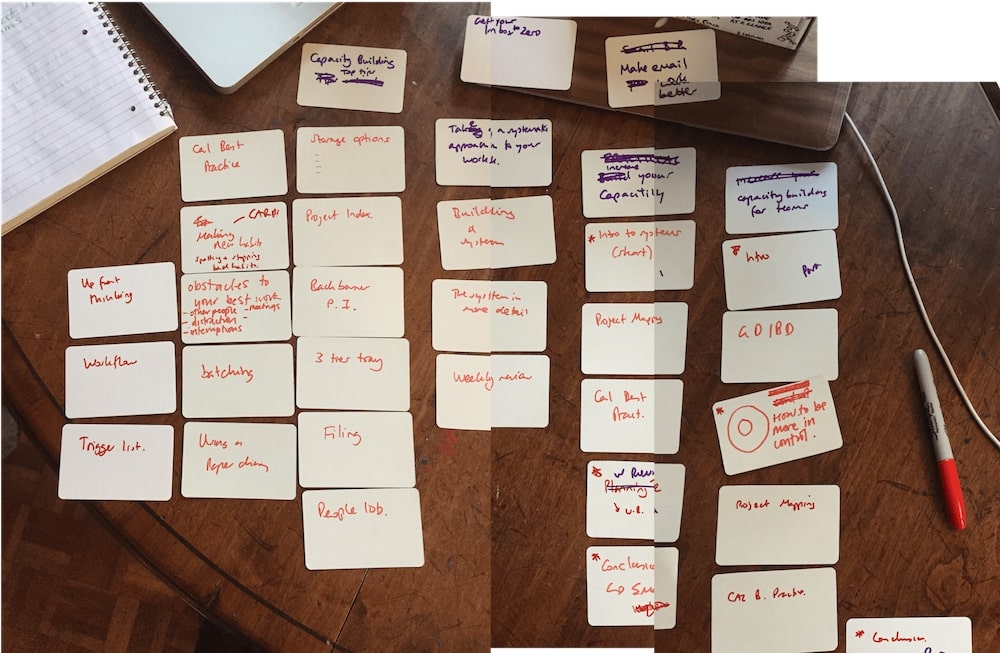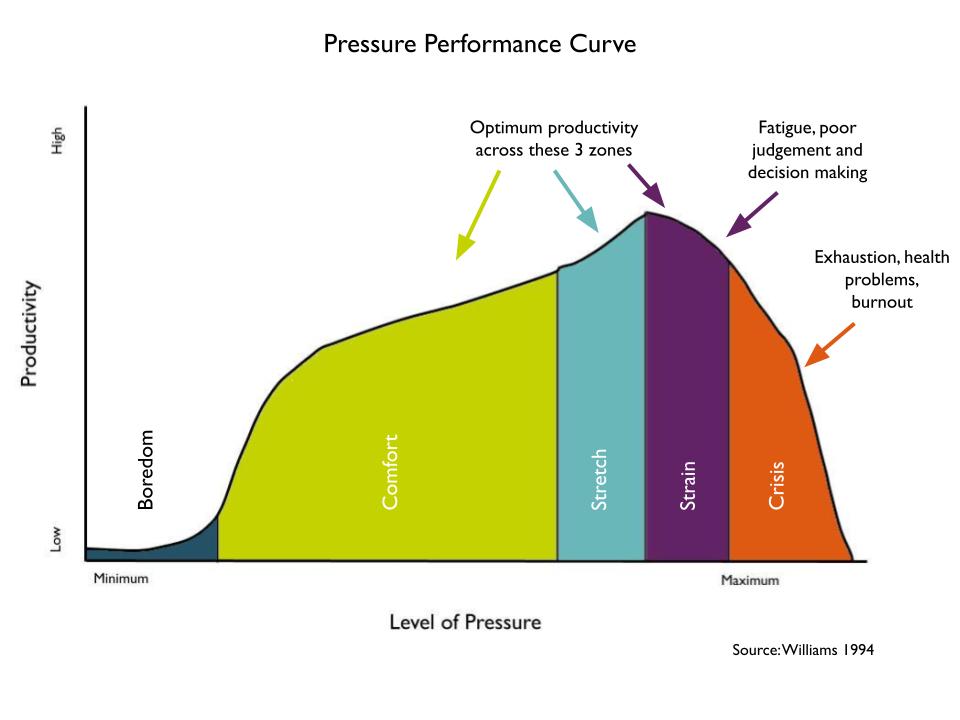Burnout – the complete mental, emotional, and often physical exhaustion brought on by long term work related stress – is a more serious and widespread issue than you might realise.
According to a 2020 Gallup survey of full time employees, when asked how often participants experienced burnout:
- 48% answered sometimes.
- 21% answered always.
That means the majority of full-time employees – nearly seven in ten people – experience burnout because of work at least some of the time.
The pressure to address this has become so important that in 2019 the World Health Organization upgraded burnout to “an occupational phenomenon”.
Why people burnout – the top 5 causes:
As workplaces become increasingly demanding and fast-paced, many employees feel overwhelmed by competing demands, unreasonable expectations and a tidal wave of communications.
Technology is at least partly to blame – being always on means the lines between home and work life are blurred – leading to long hours in front of screens without switching off.
Post-pandemic, with the surge in people working remotely from home, your team members are at greater risk of burnout now more than ever.
According to research by Gallup, there are five factors that correlate most highly with burnout:
Lack of manager support
Employees who feel supported by their manager are about 70% less likely to experience burnout. Your support as a manager provides a psychological buffer, which helps your team know you have their back when challenges come up or something goes wrong for them.
Unmanageable workload
Even high-performing colleagues can quickly shift from optimistic to hopeless when they’re struggling with unmanageable expectations and an overwhelming workload.
Unreasonable time pressure
Unreasonable deadlines and pressure can create a snowball effect: when people miss one overly aggressive deadline, they fall behind on the next thing on their to-do list.
Unfair treatment
If others get more praise or help than they do, this can make burnout more likely because it breaks trust. When team members do not trust their teammates, or do not trust you as their manager, or do not trust leadership, the psychological bond that makes work meaningful can be broken, affecting attitudes and engagement and creating more stress.
Unclear communication from managers
Unless you’re giving them the information needed to do the job effectively, people’s work becomes more difficult and frustrating.
What can you do about it
As a manager, the most impactful thing you can do to stop burnout happening in your team is to discuss with them which of the above factors are affecting them and work with them on how to spot the fires and put them out in time.
It may be that you’ll need to have a difficult conversation, or work on resolving some dysfunctional culture together.
It may be that you’ll need to adopt new behaviours and processes.
Here’s 3 behaviour changes that can help your team deal with burnout:
- Getting clear about priorities
- Saying no and setting boundaries
- Changing and reframing mindsets
1. Getting clear about priorities
Sometimes we are not the best judge of what is important, but talking with colleagues can help us get clearer.
For example, you might be making assumptions about what other people are expecting:
- If you don’t check when someone asks you to do something – why they need it and what the end goal is – you might miss that it might not be best met by the task they’re asking you to do.
- And if you don’t ask when they’ll next be working on it – you may feel you need to do it sooner than is necessary, unnecessarily adding to your current pressure and workload.
When people are overwhelmed they are more likely just to do the task than question what is most helpful.
One way to overcome this is to do an exercise such as Project Mapping together.
Project Mapping is a planning tool that helps you work out what you all have on your plate and what to prioritise.
It is a way of tracking everything, deciding what you are not going to do, and progressing the most important things.
The idea is to capture every task and project you’re involved with on cards – one thing per card – then sort the cards into appropriate areas of focus and responsibility, and work out priorities.
Once you have decided on the priorities you can get clear on what the next steps are. We recommend you work out what the next actionable step is for each task or project and then schedule it in your calendar.
This is really helpful because:
- A small amount of time upfront makes tasks and projects more manageable and much easier to make progress on.
- Identifying the smallest next step makes it easier to get started.
- Using upfront thinking helps you work out what to do – making work less stressful.
For more info on Project Mapping – have a look at our new e-course: Prioritising the Right Things.

Project Mapping helps you work out priorities.
2. Saying no and setting boundaries
It’s important that people know they can say no and set boundaries, for example by having clear start and end times (which can be flexible if your colleagues are clear about it), and stopping work at a set time like six o’clock and not carrying on just because you or they can.
It is also about taking breaks between tasks and meetings, making sure you take annual leave, and a proper lunch break!
Setting boundaries is everyone’s personal responsibility but you also have a responsibility as a manager to model it and empower them to do it.
Why boundaries are important
There’s a thing about work: it never ends, and there is never enough time to do it all.
This is important because until people realise it, they are at risk: trying to do everything leads to a destructive cycle of stress, letting other people down and eventually burnout.
The busier you get the less time you can devote to thinking or planning, which leads to more reactivity and overwhelm.
One part of the solution is to create some structure and plan your work. This helps you manage your capacity and provide a solid basis for agreeing to new work or not.
We recommend you use your calendar to get a visual reference of your capacity – so you can be better informed about what new things you can take on.
Another part of the solution is to schedule breaks – stepping away can help you see things more clearly.
It’s important to work out what you are and you are not going to do, and to prioritise what’s more important over what’s less so – doing this as a team, for example using Project Mapping, means you can decide what’s important and what to pause, together.
Saying No
Many people struggle with saying no. Saying no can be scary for many reasons – especially if you are junior and don’t wish to be seen as unhelpful or incompetent.
Yet you cannot say yes to everything. The consequences of that is taking on too much, unnecessary stress and burnout.
Does your team understand they can say no, and that saying no to some things means they can say yes to others? Or that overpromising and being unable to deliver causes more problems?
We are designed to do this together
At this point it’s worth pointing out that people can of course just start doing these things themselves, but some things work better when you discuss and iterate them together.
For example if you start saying no to everything without explaining to your colleagues, it might cause some issues. And sometimes you can’t see the wood for the trees, someone else has to hold up the mirror (and give you permission to do it).
3. Changing your mindset and reframing your thinking
Many stress management programmes tell you to reduce the sources of your stress. That is not always possible, which can end up making you feel worse.
Another way to deal with stress is to change your mindset – the set of assumptions and beliefs that affect how you think, feel and behave. You might think you can’t choose your mindset, but you can.
Health psychologist, Kari Liebowitz is an expert in using the power of mindset to improve your health, wellbeing, and performance.
Kari spent a chunk of time in the north of Norway where it’s dark half the year, and what she discovered is that people are very happy there – the opposite of what she had expected. It didn’t seem to make any sense. Why are people happier when it’s darker? It turns out it’s because they embrace winter. They don’t see the darkness as cold and uninviting. They choose to see it as soft. It is a time for intimate, slow gatherings with friends, and for spending the long days doing craft. It is a time for sleep, rest, focus, close activity. Deciding to see it like this makes for a very different experience.
She has another example of a medical trial where the doctors gave people fake mosquito bites and then injected them with histamine. Half the trial received the injection, left and then had to report on how they felt. The other half received the injection and the doctor also said, “There you go, from now on the swelling will go down and the itching will decrease.” Which is undeniable. It’s what always happens with mosquito bites, eventually, the itching reduces and the swelling goes down. Even though this was just a spurious mollification, the people who were told the swelling would go down by the doctor experienced milder symptoms for less time than those who were just left on their own.
In both of these cases, people’s experience and their body’s physiological response was influenced by their mindset.
3. Reframing your thinking
Managing your mindset is not a cure-all. Some stuff is heavy going. But once you accept that you can change your mindset, and you realise that your cup of capacity is close to overflowing, you can reframe what you can in a way that is less negative.
Here’s how to do it:
- Acknowledge and own your stress.
- Focus on what you can control (try using the Circle of Influence tool).
- Pay attention to small pleasures and emphasise the silver linings.
- Don’t be over ambitious (Covid-19 may not be the time to write that novel!)
- Watch what you talk about (try not to dwell on what can’t be changed or what might not happen.)
- Be a ‘winter mindset’ ambassador and help yourself and others feel better.
Finally: Pressure is not all bad
This chart shows that we all get more productive with a bit of pressure.

As pressure increases, performance and productivity go up until you’re into a super-performing place. But If you keep it up for too long without any respite you can slide from super-performing into strain very easily. And then from strain, you move into burnout, and a total collapse of productivity.
This means that being stressed is not bad. Because actually, you perform better when you’re in a slightly stressed state. It’s fun. It’s exciting. You can get loads done. It’s exhilarating.
The problem is to know when you’re in strain: you have to learn the signs that it might be happening, and then don’t spend too much time there.
So just be aware that your time in the stress zone is limited. And make sure that you don’t overdo it.
Otherwise, you’ll have a catastrophic collapse of productivity.
In conclusion: pay attention to yourself, and your team
As work gets more demanding it’s incumbent on managers to provide pastoral care and look out for your team – that is one of the biggest things you can do to stop your team from burning out.
Once you have an understanding of the signs, you can look out for when your’s or someone in your team’s cup is overflowing, then you can work out what to do about it.
If I start losing sleep, and wake up feeling nervous, I immediately get my notebook out and start to write things down. It helps. I discovered that by emptying my brain of all the worries and concerns, and then reprioritising, I get some sense of control back, and I sleep better.
When I’m out of control and can’t handle it anymore, writing it all down helps keep my ‘cup’ from overflowing. By doing that I’m constantly discarding things that I haven’t got room for in my cup.
You could try the same.
If this post resonates and is helpful, have a look also at our post on Burnout – how to spot the fires and put them out in time.
If you need some help with working on this – get in touch, at ThenSomehow we help you and your team build emotional literacy, increase empathy, and help you see the world differently, giving you practical tools to shift the stuff that’s stuck.
If you’d like to discuss how we can help your team deal with burnout, get in touch here.
